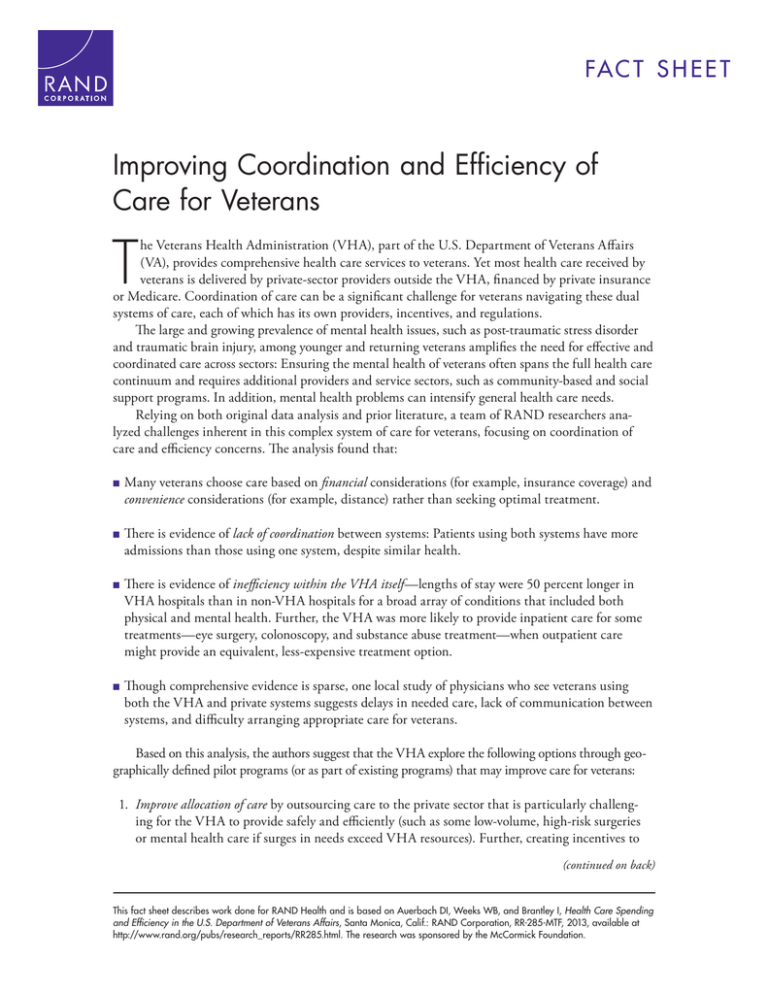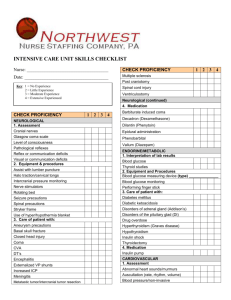T Improving Coordination and Efficiency of Care for Veterans
advertisement

FAC T S h e e t C O R P O R AT I O N Improving Coordination and Efficiency of Care for Veterans T he Veterans Health Administration (VHA), part of the U.S. Department of Veterans Affairs (VA), provides comprehensive health care services to veterans. Yet most health care received by veterans is delivered by private-sector providers outside the VHA, financed by private insurance or Medicare. Coordination of care can be a significant challenge for veterans navigating these dual systems of care, each of which has its own providers, incentives, and regulations. The large and growing prevalence of mental health issues, such as post-traumatic stress disorder and traumatic brain injury, among younger and returning veterans amplifies the need for effective and coordinated care across sectors: Ensuring the mental health of veterans often spans the full health care continuum and requires additional providers and service sectors, such as community-based and social support programs. In addition, mental health problems can intensify general health care needs. Relying on both original data analysis and prior literature, a team of RAND researchers analyzed challenges inherent in this complex system of care for veterans, focusing on coordination of care and efficiency concerns. The analysis found that: ■ Many veterans choose care based on financial considerations (for example, insurance coverage) and convenience considerations (for example, distance) rather than seeking optimal treatment. ■ There is evidence of lack of coordination between systems: Patients using both systems have more admissions than those using one system, despite similar health. ■ There is evidence of inefficiency within the VHA itself—lengths of stay were 50 percent longer in VHA hospitals than in non-VHA hospitals for a broad array of conditions that included both physical and mental health. Further, the VHA was more likely to provide inpatient care for some treatments—eye surgery, colonoscopy, and substance abuse treatment—when outpatient care might provide an equivalent, less-expensive treatment option. ■ Though comprehensive evidence is sparse, one local study of physicians who see veterans using both the VHA and private systems suggests delays in needed care, lack of communication between systems, and difficulty arranging appropriate care for veterans. Based on this analysis, the authors suggest that the VHA explore the following options through geographically defined pilot programs (or as part of existing programs) that may improve care for veterans: 1. Improve allocation of care by outsourcing care to the private sector that is particularly challenging for the VHA to provide safely and efficiently (such as some low-volume, high-risk surgeries or mental health care if surges in needs exceed VHA resources). Further, creating incentives to (continued on back) This fact sheet describes work done for RAND Health and is based on Auerbach DI, Weeks WB, and Brantley I, Health Care Spending and Efficiency in the U.S. Department of Veterans Affairs, Santa Monica, Calif.: RAND Corporation, RR-285-MTF, 2013, available at http://www.rand.org/pubs/research_reports/RR285.html. The research was sponsored by the McCormick Foundation. provide treatment for an episode of care within a single system may reduce unnecessary duplication of services. 2. Facilitate better coordination of care across systems by making a single health care entity (the VHA or the private sector) accountable for the total cost and quality of care received by veterans, regardless of where care is received. This arrangement could foster greater collaboration; better sharing of data and information; and initiatives, such as public-private partnerships between the VHA and private health systems, where it makes sense to do so. To determine whether such changes improve efficiency, future evaluations should consider ease of implementation and assess impacts in several areas, including quality of care; equity in resource allocation; feasibility; and VA, federal, and other spending. The RAND Corporation is a nonprofit institution that helps improve policy and decisionmaking through research and analysis. RAND’s publications do not necessarily reflect the opinions of its research clients and sponsors. R is a registered trademark. ® © RAND 2013 www.rand.org RB-9712-MTF (2013) CHILDREN AND FAMILIES EDUCATION AND THE ARTS The RAND Corporation is a nonprofit institution that helps improve policy and decisionmaking through research and analysis. ENERGY AND ENVIRONMENT HEALTH AND HEALTH CARE INFRASTRUCTURE AND TRANSPORTATION This electronic document was made available from www.rand.org as a public service of the RAND Corporation. INTERNATIONAL AFFAIRS LAW AND BUSINESS NATIONAL SECURITY POPULATION AND AGING PUBLIC SAFETY SCIENCE AND TECHNOLOGY TERRORISM AND HOMELAND SECURITY Support RAND Browse Reports & Bookstore Make a charitable contribution For More Information Visit RAND at www.rand.org Explore the RAND Corporation View document details Research Brief This product is part of the RAND Corporation research brief series. RAND research briefs present policy-oriented summaries of individual published, peer-reviewed documents or of a body of published work. Limited Electronic Distribution Rights This document and trademark(s) contained herein are protected by law as indicated in a notice appearing later in this work. This electronic representation of RAND intellectual property is provided for noncommercial use only. Unauthorized posting of RAND electronic documents to a non-RAND website is prohibited. RAND electronic documents are protected under copyright law. Permission is required from RAND to reproduce, or reuse in another form, any of our research documents for commercial use. For information on reprint and linking permissions, please see RAND Permissions.
